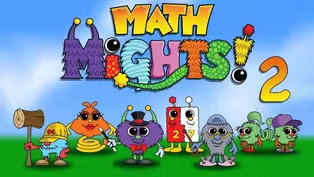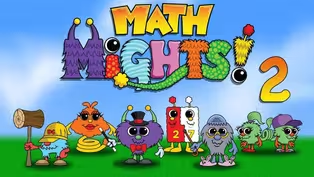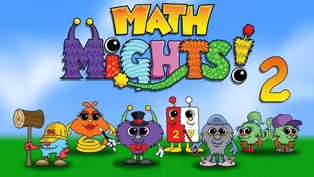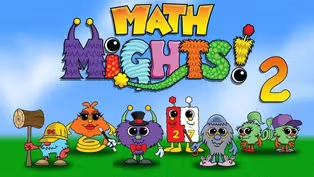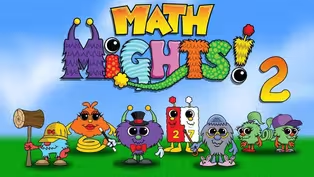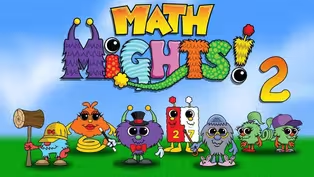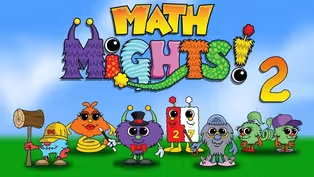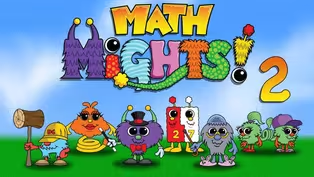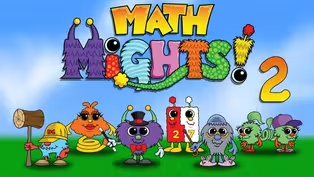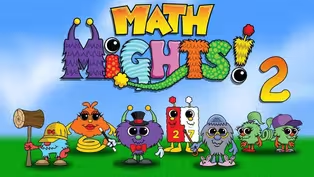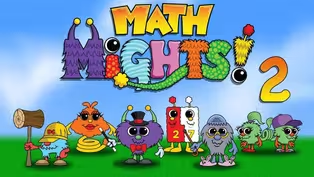Math Mights
Subtraction with 2-Digit Numbers Part 1
Season 2 Episode 215 | 16mVideo has Closed Captions
Join Mrs. McCartney for an addition number talk with D.C.!
Join Mrs. McCartney for an addition number talk with D.C.! Get your math brain ready as we meet T-Pops and have some fun subtracting two-digit numbers.
Problems playing video? | Closed Captioning Feedback
Problems playing video? | Closed Captioning Feedback
Math Mights is a local public television program presented by Detroit PBS
Math Mights
Subtraction with 2-Digit Numbers Part 1
Season 2 Episode 215 | 16mVideo has Closed Captions
Join Mrs. McCartney for an addition number talk with D.C.! Get your math brain ready as we meet T-Pops and have some fun subtracting two-digit numbers.
Problems playing video? | Closed Captioning Feedback
How to Watch Math Mights
Math Mights is available to stream on pbs.org and the free PBS App, available on iPhone, Apple TV, Android TV, Android smartphones, Amazon Fire TV, Amazon Fire Tablet, Roku, Samsung Smart TV, and Vizio.
Providing Support for PBS.org
Learn Moreabout PBS online sponsorshipMore from This Collection
"Math Mights" lessons for 2nd Grade students.
Video has Closed Captions
Join Mrs. McCartney for some fun with Professor Barble. (15m 59s)
Video has Closed Captions
Join Mrs. McCartney for some fun with Professor Barble. (15m 59s)
Video has Closed Captions
Join Mrs. McCartney for some fun with Professor Barble doing a tricky comparison. (15m 59s)
Video has Closed Captions
Join Mrs. McCartney for a word problem with Professor Barble that will make more sense. (15m 58s)
Video has Closed Captions
Join Mrs. McCartney for a comparison word problem with her friend Professor Barble. (15m 59s)
Compare 3-Digit Numbers Part 2
Video has Closed Captions
Join Mrs. McCartney to learn how to do a comparison word problem with Professor Barble! (15m 59s)
Comparing Numbers on a Number line
Video has Closed Captions
Join Mrs McCartney for a word problem with Professor Barble using Visula Models! (15m 59s)
Compare 3-Digit Numbers Part 1
Video has Closed Captions
Join Mrs. McCartney to see if we can figure out Professor Barble's comparison. (15m 59s)
Numbers represented in different ways
Video has Closed Captions
Representing numbers in different ways to show off your learning with place value. (15m 59s)
Video has Closed Captions
Put numbers together and taking them apart with expanded form. (15m 59s)
Video has Closed Captions
Join Mrs, McCartney for a Number Talk with her friend Springling! (15m 59s)
Video has Closed Captions
Join Mrs, McCartney for a Number Talk with her friend Springling! (16m)
Providing Support for PBS.org
Learn Moreabout PBS online sponsorship(upbeat music) ♪ Mathville ♪ - Welcome back, second grade Math Might friends.
Thanks so much for joining us today.
My name is Mrs McCartney and we are going to have so much fun in math.
Let's check out our plan for today.
Today, we're gonna start off with a Number Talk from our friend DC, and then we are going to do something so fun with subtraction, looking at a two digit strategy that I think that you're going to be able to do.
Let's start off first with our Number Talk looking at our Number Talks stems that we're going to think about as we're walking our way through this Number Talk with addition.
We might find a time when you may disagree with somebody answer or you might wanna be able to tell exactly how a person did it in a certain way.
During a Number Talk, you can communicate your ideas along with your friend's ideas to figure out how you might solve problems.
Today in our Number Talk we're going to be using our friend DC again to show how strong you are using DC's powers to be able to make friendly numbers.
(upbeat music) Are you ready for our problem?
Our problem that DC wants us to solve is a two digit plus a two digit, 33 plus 47.
Let's think about that just for a minute.
This is a little bit harder than thinking of it with the two digit plus a single digit because now we have two digits to think of.
Which number are you leaning towards to make the friendly number.
Are you wanting to make the 33, the friendly number or do you feel like 47 is closer to a friendly number?
Let's see how our friend Mia solve this problem, 33 plus 47.
It looks like Mia decided to make that 33, a friendly number.
How did she get 40 plus 40 out of 33 plus 47?
Let's check it out to see what this looks like.
We have 33 plus 47.
Mia decided to make this a double that she is familiar with.
She knows that 33 is really close to 40.
So she decided to take that 47, use DC strategy, decompose the 47 by adding the seven here to make a friendly decade number leaving 40 left on this side.
If she adds seven to 33, she's going to get a nice friendly number 40.
When she adds it to the 40 over here she gets the total of 80.
I bet DC is gonna be so excited about the way Mia chose to do this strategy because it kind of made it a lot easier to think of by thinking of it as 40 plus 40.
I wonder what our friend Matthew is going to think about the way Mia solved this problem.
He said he really agrees with her answer but he wants to solve it with DC another way.
Let's check out to see how Matthew solved it.
He decided to look at the problem and instead of making the 33 a 40, he looked more at that 47.
He made his new problem be 30 plus 50.
Let's check out to see how Matthew solved it.
33 plus 47.
He really wants to be able to make that 47 of 50.
So he decided to use DC strategy and decompose the 33, bringing the three over here because he knows it's gonna get that nice friendly number 50, leaving him 30 left over here.
Once he adds the 47 to the three, he gets a very friendly decade number 50 simply adds that to the 30 and gets that 80 answered quite quickly.
I think that Mia and Matthew both did a great job solving these problems with DC.
They made a problem that looked more complicated that you might have to stack up and maybe do on pencil and paper, easily by doing it mentally in their head using DC strategy.
Let's check out our, I can statement of the day.
I can subtract two digit numbers.
Oh, we are gonna have a face off with DC and T-pops strategy today.
I'm so excited for you to check out the way that DC and T-pops solved problems in Mathville.
Before we star off learning about T-pops in DC strategies, Let's first look at the vocabulary, when we're talking about subtraction.
These are funny words, but the first word is minuend.
That is the first number in a subtraction problem.
Subtrahend is the second.
You might know these with addition problems as the add ins but we call them minuend and subtrahend.
A lot of second graders always ask the question, when do I need to regroup or what is it a non regroup?
Well, it's how we're looking at the minuend and the subtrahend, let's take a look here.
I have 56 minus 34.
The first number is the minuend, and the second number is the subtrahend.
I'm gonna look first in the ones count.
I was doing this T-pos way and look at that minuend.
If the menu one is larger than the subtrahend there's no regroup needed, because if I have six ones I can very easily take away that subtrahend.
One two, three, four, and I'm left with two.
When we go over to a different problem, 42 minus 17.
Again if I was looking at it this way to see if I need to regroup two minus seven, our minuend in this case is smaller than our subtrahend.
So if I had two, can I take seven away?
No, I can't, there's not enough.
So this would cause for us to be able to regroup which we could do with both DC and T-pops.
Today we're gonna focus on problems that are considered non regroups this way.
So we can understand the strategy and then we'll start to understand the strategies doing it with a regroup.
You might be wondering if the problem is written horizontal versus stacked.
Can you still tell if you have to regroup or not regroup?
Let's take a look here.
We have 54 minus 32.
This is the minuend, so let's underline the ones column that we see out of our ones and our tens.
Then we have our 32 with the ones.
Our minuend is greater than our subtrahend.
So it's gonna be a non regroup.
'Cause if I have four ones, I can take away two ones.
Versus this problem is 52 minus 27.
Again, if I underlined the two and the seven, the minuend in this case is less than the subtrahend, which is seven.
So if I have two, I can't take that away.
This makes this a regrouped problem.
Let's take a look to see how we can do some of these non regroup problems with DC and T-pops.
Let's take a look to see how they solve this problem, 35 minus 23.
T-pops has his way, DC has his way.
What are you wondering or what are you noticing about the strategies that they used?
How are they the same and how are they different?
Now T-pops is the oldest citizen in Mathville.
He's been there forever.
He loves the traditional way line him up and just subtract.
DC you're familiar with the addition but he has a certain way that he looks about things in subtraction and sometimes there's regrouping in subtraction.
So DC strategy might have to change as we go.
What are you thinking as you look at these two strategies?
Let's take a closer look to see what this looks like.
We know that T-pops is kind of building that first number what we call the minuend in subtraction with 35.
DC is looking at that number 35 and kind of thinking of the values of the number being 30 and five.
Let's take a look while we build this on our place value map.
Let's start off by writing the problem the way T-pops does with it's stacked on our dry erase board on our T-pops place value mat.
I'm gonna write the 35 at the top and the 23 at the bottom.
I'm gonna build the first number the way that T-pops does.
Although T-pops does the traditional way in Mathville he loves it when kids really can think about the other ways of solving before they come to him.
So we're gonna build that 30 that matches the value here.
And then I'm going to put the five ones in the one column to match the fives.
Sometimes when students look at these numbers they call them a three.
Even though we know it's three tens, like it matches here and then we have five ones.
So T-pops is great if you want to use his traditional method.
But the only thing he reminds you of is to make sure you're using the values of the numbers.
So let's take a look as we try to solve this problem by first building that 35.
If we were to compare this to the way that DC solves this, he thinks of that 35 but kind of thinks of it within its values of 30 and five.
We're gonna build the subtrahend at the bottom of our T-Pop's place value map because this is how many we have to take away from the 35.
We're gonna separate this by the place value and try to walk our way through this problem.
I know that I have to take three away so I'm gonna stack one, two, three from my five and tell someone I want to take it away.
I know when I took those five ones and I took away the three ones that we are left with only two.
Some of us might say three minus two but T-pops wants us to use the value.
It's to take this 20 away from the 30 or 30 minus 20.
So we're gonna put our 10 and then our 20 and say to someone, take it away.
And we're gonna get what is left 30 minus 20 leaves us with 10.
How does this compare when we start to look at DC's strategy?
Over here we kind of have T-pops way but we're gonna show this way over here, looking at DC.
He likes to decompose the numbers and be able to subtract them.
Does he end up looking at it the same way by decomposing it with the values?
He is able to do five minus three and is still able to get that to just like T-pops and then he took the 30 minus the 20 and ended up getting 10, just like T-pops.
As we look at these different ways to solve, we can see that they are able to use a strategy that is really similar, but it's really using the values of the numbers.
So who did you like solving with better DC or T-pops?
I wonder if you can challenge yourself and solve it both ways.
These problems are without regrouping.
So we wanna become really good at solving problems like this first.
Let's check out the next problem that DC and T-pops want us to try out, 56 minus 34.
I wonder how we can solve this one together.
Let's take a look at our T-pops place, value board and build this problem.
Let's first, write it on the dry erase board the way T-pops thinks of it.
So we can really use the values of the numbers.
56 minus 34.
I'm gonna go ahead and build the mini one, the first number in our problem with the discs.
So I'm going to go ahead and do 10 20, 30, 40, 50.
That's what our five represents and I'm gonna put in six ones.
Now I have my six ones, so I have five tens and six ones to equal my 56.
On this side we're gonna kind of think about how DC thinks of it.
So I kind of have my T-pops way and then I have my DC way, which is 50 and six.
We're now going to take away 34.
So at the bottom, I'm gonna build my subtrahend because I need to take away 34 from my 56.
So let's check out how T-pops would do it.
He would take his four and say, give me from that six I want to have four of them.
One, two, three, four.
And he says, let's take that away.
How many do we have left?
When we do six minus four.
We know that we only have two ones left.
If we compare this to DC's way we would still get the same thing.
If we took six and we took away four we know we would end up with that too.
Let's now go over to T-pops, taking our 50 and we need to take away 30.
So 10, 20, 30 take it away.
When we take our 50 minus our 30 or five tens minus our three tens not five minus three.
T-pops wants to use that place value.
We're left with two tens or 20.
Same thing here, if I took the 50 and I took away 30 looking at DC's way I would still end up with 22.
Their strategies are connected and are really going to help you when we start to regroup.
Once you start to be able to regroup with numbers you're going to be able to describe it the way DC does it which is gonna help you understand that traditional method a lot better.
Let's take a look at this friend of ours, Connor who is solving a math problem.
I wonder how it's going to work out with DC doing it and T pops doing it.
I noticed something a little bit different about this problem.
We're gonna do more of these types of problems as we keep working through our understanding in subtraction.
It's now your turn to try it on your own.
Do you think that you can solve for problems with DC's way by decomposing numbers to subtract?
If you wanted to show how T-pops did it with it you could try both strategies at the same time.
We hope that you had a fun time with us in Mathville and will join us next time as we start to do these strategies with regrouping.
Thanks so much for joining us.
(upbeat music) (gentle music) - [Child] sis4teachers.org, changing the way you think about math.
- [Woman] This program is made possible with funding from the Michigan department of education.
Governor's Education Emergency Funds, the state of Michigan and by viewers like you.
(upbeat music)


- Home and How To

Hit the road in a classic car for a tour through Great Britain with two antiques experts.












Support for PBS provided by:
Math Mights is a local public television program presented by Detroit PBS
